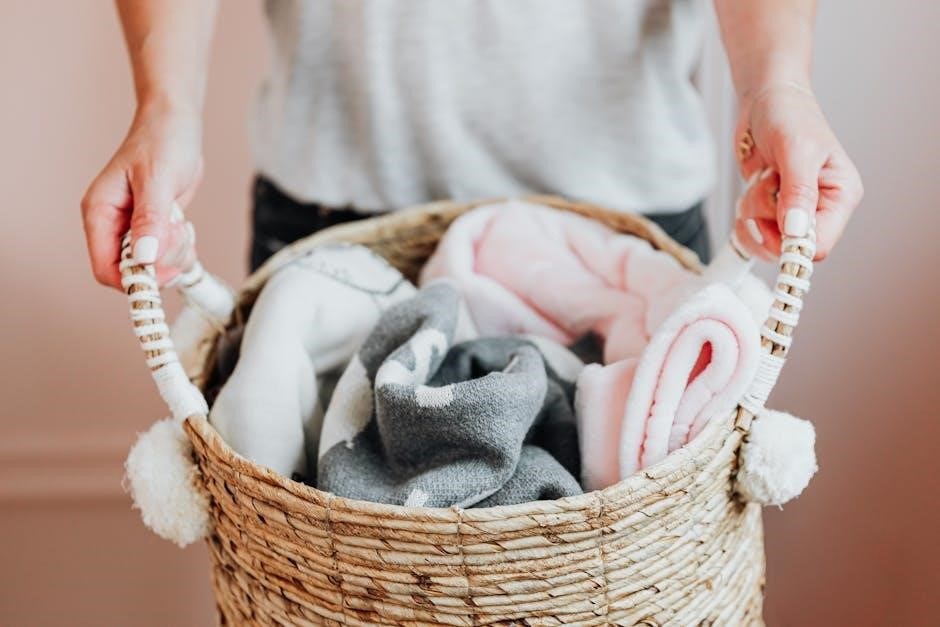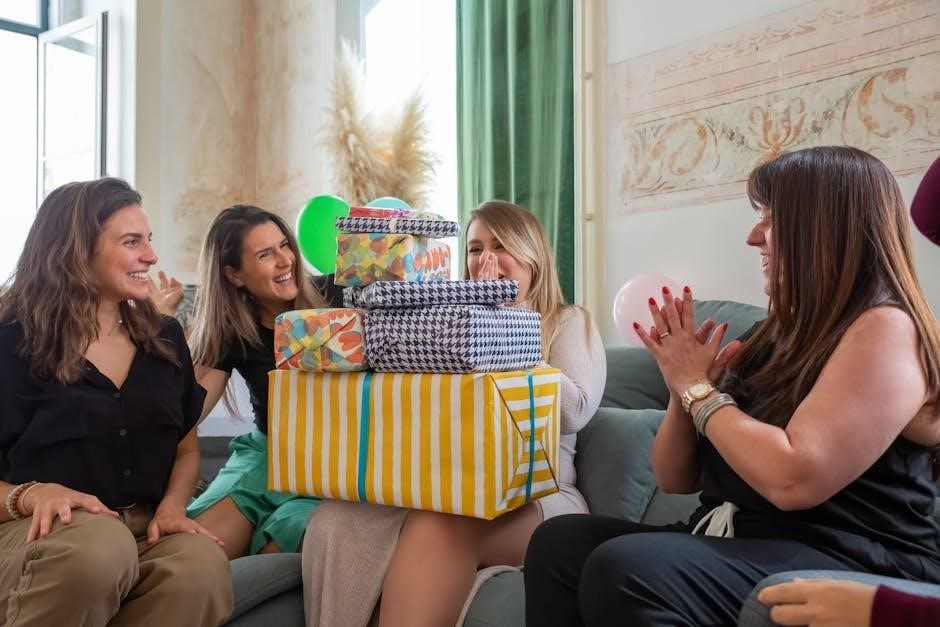A baby wrap is a simple, versatile tool for carrying your little one close while keeping your hands free. This guide provides step-by-step instructions, safety tips, and expert advice to help you master babywearing confidently and comfortably.
What is a Baby Wrap?
A baby wrap is a long, flexible piece of fabric designed to hold your baby close to your body, allowing for hands-free parenting. It is typically made of soft, breathable materials and can be either stretchy or woven, offering different levels of support and flexibility. Unlike structured carriers, a baby wrap is completely adjustable, making it suitable for various body types and baby sizes. By wrapping the fabric around your torso and securing it with a knot, you create a snug, secure space for your baby to rest, promoting comfort and closeness. It distributes the baby’s weight evenly across your shoulders and hips, making it a popular choice for many parents.
Benefits of Using a Baby Wrap
A baby wrap offers numerous benefits for both parents and babies. It promotes bonding through close contact and skin-to-skin interaction, which can be comforting for the baby. The wrap is versatile, allowing for front and back carrying positions, making it convenient for different situations. It is practical, as it eliminates the need for a diaper bag by providing storage for small items. The wrap is adjustable, ensuring a perfect fit for various body types and baby sizes, and it grows with the baby. It is easy to use, with instructions or videos available for guidance. Made from breathable, stretchy fabric, it keeps both parent and baby comfortable. The wrap distributes the baby’s weight evenly, preventing strain, and allows for discreet nursing. Overall, it is a cost-effective and comfortable solution for hands-free parenting.
Types of Baby Wraps (Stretchy vs. Woven)
Baby wraps come in two main types: stretchy and woven. Stretchy wraps are made of soft, flexible fabric that provides a snug fit, ideal for newborns and younger babies. They are easy to use and require minimal adjustment, making them perfect for front carrying and quick errands; Woven wraps, on the other hand, are made from sturdy, non-stretchy material, offering excellent support for heavier babies and toddlers. They are more versatile, supporting back and hip carries, and can be customized for different body types. Both types are safe and comfortable when used correctly, but the choice depends on personal preference, baby’s age, and carrying needs. Stretchy wraps are great for simplicity, while woven wraps offer long-term durability and flexibility.

Safety Considerations
Always follow the T.I.C.K.S. rule for safe babywearing: baby must be Tight, In view, Close enough to kiss, with Chin off chest, and Supported back.
The T.I.C.K.S. Rule for Safe Babywearing
The T.I.C.K.S. rule ensures your baby is carried safely in a wrap. Tight: The wrap should hold your baby snugly, preventing sagging. In view: Always keep your baby visible so you can monitor their breathing and comfort. Close enough to kiss: Your baby should be within reach of your lips to ensure they are at a safe height. Chin off chest: Ensure your baby’s airway is open by keeping their chin up, allowing two fingers to fit under their chin. Supported back: Your baby’s back should be straight and secure, maintaining a natural posture. Following these guidelines helps promote a safe and comfortable babywearing experience.
Ensuring Proper Support for Baby’s Neck and Back
Proper support for your baby’s neck and back is essential for safe and comfortable babywearing. Ensure the wrap is snug and evenly distributed across your baby’s back, with the fabric wide and flat to provide adequate support. For newborns, the wrap should be tight enough to keep their neck in a neutral position, allowing their chin to rest slightly upward. As your baby grows, their back should remain straight, with their knees slightly above their hips to maintain a natural posture. Adjust the wrap panels to ensure even weight distribution and prevent strain on your baby’s spine. Regularly check the fit to ensure your baby’s comfort and proper alignment.
Safe Positions for Baby (Legs-In vs. Legs-Out)
When using a baby wrap, it’s important to position your baby safely and comfortably. For newborns, the legs-in position is recommended, as it provides optimal support for their tiny legs and hips, promoting healthy development. As your baby grows, you can transition to the legs-out position, which allows for greater mobility while ensuring proper hip alignment. Always ensure your baby’s knees are slightly above their hips, forming a natural “M” shape when legs are out. The T.I.C.K.S. rule applies to both positions: your baby should be tight, in view, close enough to kiss, with their chin off their chest and back supported. Monitor your baby’s comfort and adjust as needed to ensure a safe and enjoyable experience.

Step-by-Step Instructions for Using a Baby Wrap
Mastering the baby wrap involves simple, clear steps. Start by positioning the wrap, creating an “X” across your back, tightening for snugness, and placing your baby securely. Ensure the T.I.C.K.S. rule is followed for safety and comfort, and finish with a secure knot. This hands-free method allows for easy, enjoyable babywearing.
Step 1: Positioning the Wrap
Start by holding the baby wrap with the label facing outward and centered across your chest. The wrap should be positioned high, just below your bust, ensuring it sits comfortably above your waist. Gently spread the fabric wide across your back, keeping it flat and untwisted. This initial positioning is crucial for distributing your baby’s weight evenly and maintaining a secure fit. Make sure the wrap is snug but not restrictive, as this will ensure both you and your baby are comfortable throughout the day. Proper positioning sets the foundation for a safe and enjoyable babywearing experience.
Step 2: Creating the “X” Across Your Back
After positioning the wrap correctly, bring the two ends behind your back, ensuring the fabric remains flat and untwisted. Cross the ends over each other to form an “X” shape. This step is crucial for distributing the baby’s weight evenly and achieving a secure fit. Keep the fabric snug but not overly tight, as this will ensure both comfort and proper support. Adjust the ends so they lie flat against your back, maintaining the “X” formation. This setup provides the foundation for a balanced and comfortable carry, allowing you to move freely while keeping your baby close. Properly forming the “X” ensures a safe and enjoyable babywearing experience.
Step 3: Tightening the Wrap
Once the “X” is in place, it’s time to tighten the wrap for a secure fit. Start by adjusting the shoulder panels, ensuring they lie flat and evenly across your back. Gently pull the ends of the wrap to remove any slack, making sure the fabric feels snug but not restrictive. Use both hands to lift the panels upward, tightening the wrap while maintaining the “X” formation. This step ensures the baby will be held at a safe, “kissable height” and provides optimal support. Be careful not to over-tighten, as this could cause discomfort. Once tightened, tuck any excess fabric into the panels to keep the wrap neat and secure. Proper tightening ensures a balanced and comfortable carry for both you and your baby.
Step 4: Placing Baby in the Wrap
To place your baby in the wrap, start by leaning back slightly to support their weight. Hold your baby close to your chest, ensuring their head is at “kissable height” and their body is upright. Identify the panel closest to your body and gently slide your baby into the wrap, guiding their legs through the fabric. Spread the material evenly across their back, forming an “M” shape with their knees slightly above their bum for proper support. Adjust the panels to ensure the fabric is snug but not too tight, keeping your baby secure and comfortable. Make sure their chin is off their chest and their back is straight, following the T.I.C.K.S. rule for safety. Once positioned, you can proceed to secure the wrap.
Step 5: Securing the Knot
To secure the knot, bring both ends of the wrap together in front of you and tie a double knot to ensure it stays in place. Make sure the knot is snug but not overly tight, as this can cause discomfort. Tuck any excess fabric under the panels to keep the wrap tidy and evenly distributed. For added security, you can also bring the ends behind you and tie them again, creating a reinforced knot. Once the knot is tied, gently tug on the wrap to ensure it feels stable and supportive for your baby. This step is crucial for maintaining a safe and comfortable position for your little one throughout the day.

Tips for Using a Baby Wrap
Discover expert tips for optimal babywearing, including adjusting wraps for front and back carrying, nursing discreetly, and using wraps in various weather conditions.
Adjusting the Wrap for Front and Back Carrying
Adjusting a baby wrap for front or back carrying ensures comfort and support for both you and your baby. For front carrying, place the wrap around your torso, crossing the ends behind you to form an “X” across your back. Tighten the fabric evenly to keep your baby at kissable height, ensuring their neck and back are properly supported. For back carrying, bring the panels over your shoulders and secure the wrap with a double knot. Make sure the baby is snug and close, with their knees slightly above their bum for optimal positioning. Adjustments may be needed to distribute weight evenly and maintain comfort.
Nursing in a Baby Wrap
Nursing in a baby wrap allows for discreet and convenient feeding while keeping your baby close. To nurse, slightly lower the wrap to bring your baby to breast height, ensuring their head is at nipple level. Keep your baby upright and straight, avoiding a diagonal position, as this can compromise their airway and latch. Use one hand to guide your baby to the breast while adjusting the wrap with the other. Ensure the fabric is snug but not restrictive, and your baby’s chin is off their chest for proper breathing. For extra support, tuck the shoulder panels gently behind your baby’s neck. Practice makes this process smoother, allowing you to nurse comfortably and securely while wearing your baby.
Using a Baby Wrap in Different Weather Conditions
When using a baby wrap in different weather, consider your baby’s comfort and safety. In summer, opt for lightweight, breathable wraps made from natural fabrics like cotton or bamboo to keep your baby cool. In winter, layer with a cozy hoodie or jacket over the wrap to maintain warmth. For rainy weather, use a water-resistant cover or wear a raincoat to protect both you and your baby. Ensure proper ventilation to prevent overheating and always check your baby’s temperature. Avoid bulky clothing that could affect the wrap’s snugness, and keep your baby’s airway clear. By adjusting your approach to the weather, you can enjoy babywearing year-round while keeping your little one comfortable and secure.
Troubleshooting Common Issues
Common problems like sagging or discomfort can be fixed by adjusting the wrap’s tension or repositioning your baby for better support and alignment.
Why Baby Might Sag in the Wrap
Baby sagging in the wrap is often due to improper tightening or positioning. If the fabric isn’t snug or the wrap is twisted, it can cause your baby to slump, compromising support. Ensure the wrap is tight enough to keep your baby at “kissable height” and their back straight. A loose wrap or uneven distribution of fabric can lead to sagging, making it uncomfortable for both you and your baby. Regularly check the tension and adjust as needed to maintain proper alignment. This ensures your baby stays secure and comfortable, adhering to the T.I.C.K.S. safety guidelines for babywearing.
Fixing a Twisted or Uneven Wrap
A twisted or uneven wrap can cause discomfort and affect the safety and security of your baby. To fix this, start by loosening the wrap slightly and gently guiding the fabric back into its proper position. Ensure the panels are spread evenly across your shoulders and back, avoiding any bunching or overlapping. For a stretchy wrap, you can adjust the shoulder panels by lifting and smoothing them outward. For woven wraps, re-tightening the passes and ensuring the fabric lies flat will help restore balance. Regular adjustments during use can prevent the wrap from becoming uneven, ensuring a comfortable and secure carry for your baby. Always double-check the wrap’s alignment to maintain optimal support.
Solving Discomfort or Tightness
Discomfort or tightness in a baby wrap can often be resolved by adjusting the fabric and ensuring proper positioning. Start by loosening the wrap slightly and redistributing the baby’s weight evenly. Check that the shoulder panels are not bunched or digging into your skin—adjust them to lie flat and wide across your shoulders. For stretchy wraps, gently pull the fabric to release any tension and ensure the baby is at “kissable height.” For woven wraps, re-tighten the passes and adjust the knot to relieve pressure. Ensure the baby’s legs are properly positioned, with knees slightly above their bum, to avoid strain on their hips. Regular adjustments during use can help maintain comfort for both you and your baby. Always prioritize a snug yet non-restrictive fit.

Advanced Techniques
Mastering advanced baby wrap techniques involves perfecting back carrying, switching between positions, and adjusting for different ages and sizes. These methods enhance comfort and versatility.
Mastering Back Carrying
Back carrying is a convenient option for older babies and toddlers, offering better weight distribution and freeing your front for tasks. Start by practicing with a doll or stuffed animal to build confidence. Position the wrap snugly around your torso, ensuring the fabric is flat and evenly spread. Bring the ends behind you to form an “X” across your back, then loop them under your arms and secure with a double knot. For safety, always maintain the T.I.C.K.S. rule: ensure your baby is Tight, In view, Close enough to kiss, with their Chin off their chest and Supported back. Adjust the wrap as needed for comfort and support. Regular practice will help you and your baby feel secure and comfortable in this position.
Using a Baby Wrap for Different Ages and Sizes
Baby wraps are versatile and can be used from newborn stages through toddlerhood, adapting to your child’s growth. For newborns, ensure a snug fit with legs-in positioning to support their tiny bodies. As your baby grows, transition to legs-out carries for comfort and mobility. Older babies and toddlers may require a sturdier fabric, like a woven wrap, for better support. For larger children, focus on maintaining proper posture and distributing weight evenly. Always follow the T.I.C.K.S. rule to ensure safety. Adjust the wrap as needed to accommodate your child’s size and age, and practice makes perfect for a comfortable, secure fit. Regular use will help you master the technique for any stage.
Switching Between Carrying Positions
Switching between front and back carrying positions with a baby wrap requires careful adjustment to ensure comfort and safety. Begin by loosening the wrap slightly, then gently lift your baby and reposition them to the desired location. For back carrying, guide your baby onto your back while maintaining support under their knees and behind their neck. When transitioning to front carrying, bring your baby forward slowly, ensuring the wrap remains snug and evenly distributed. Always check the T.I.C.K.S. rule after repositioning to guarantee your baby’s safety. Practice makes perfect—mastering this technique will allow you to switch positions seamlessly while keeping your baby secure and content.

Safety and Maintenance
Regular cleaning and proper storage of your baby wrap are essential for maintaining its quality and ensuring your baby’s safety. Always check for wear and tear before use to prevent accidents. Follow the manufacturer’s care instructions to keep your wrap clean and durable. Store the wrap in a dry, cool place to avoid damage. By maintaining your wrap, you can ensure it remains a safe and reliable tool for babywearing.
Cleaning and Caring for Your Baby Wrap
To keep your baby wrap in excellent condition, always check the care label for specific instructions. Most wraps can be hand-washed gently with mild detergent and lukewarm water. Avoid machine washing or using harsh chemicals, as they may damage the fabric. Air-dry the wrap to maintain its softness and prevent shrinkage. For spot cleaning, dampen a soft cloth and gently blot the area without rubbing. Sanitize the wrap by adding a small amount of vinegar to the rinse water. Store the wrap in a cool, dry place, away from direct sunlight, to prevent fading or damage. Regular cleaning and proper storage ensure your baby wrap remains safe, comfortable, and long-lasting for extended use.
Storing the Wrap Properly
Proper storage is essential to maintain the quality and longevity of your baby wrap. When not in use, avoid folding or twisting the wrap, as this can cause creases or uneven stretching. Instead, gently lay the wrap flat in a cool, dry place, away from direct sunlight. For extended storage, consider rolling the wrap neatly and placing it in a breathable fabric bag or drawer. Avoid storing it in plastic bags, as this can trap moisture and lead to mildew. Ensure the wrap is completely dry before storing to prevent any odor or damage. By storing your wrap correctly, you’ll keep it in pristine condition for future use.
Final Tips for Successful Babywearing
To ensure a positive experience with your baby wrap, always remember to keep it snug and adjust as needed. Practice makes perfect, so don’t be discouraged if it takes time to get comfortable. Start with short sessions and gradually increase as you and your baby grow accustomed to it. Stay mindful of your posture to avoid discomfort and evenly distribute your baby’s weight. Lastly, trust your instincts—if something feels off, make adjustments to ensure both you and your baby are comfortable and safe. With these tips, you’ll master babywearing in no time!
Enjoying the Benefits of Babywearing

Babywearing offers countless benefits, from strengthening your bond with your baby to providing convenience for daily activities. By keeping your little one close, you foster a sense of security and comfort, which can promote emotional well-being. Many parents find that babywearing helps with soothing fussy babies and even supports breastfeeding. Additionally, it allows for hands-free parenting, making tasks like grocery shopping or hiking easier. Over time, you’ll discover the unique ways your baby responds to being carried, and you’ll enjoy the freedom and connection it brings. Embrace this special time and cherish the extra cuddles—it’s a journey that benefits both you and your baby in countless ways.

